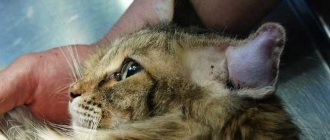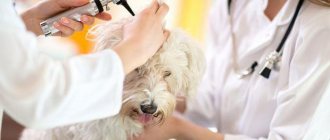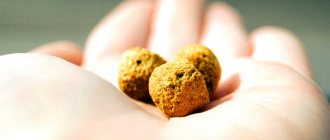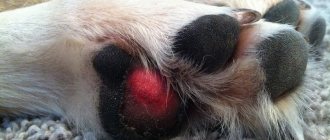Symptoms of infectious diseases
An infection of the ear canal is usually accompanied by the following phenomena:
- Swelling of the skin.
- Excessive discharge.
- Unpleasant smell.
- Heat.
- Poor appetite.
- Itching and severe pain.
- Redness.
A sick dog will whine and constantly touch its ears with its paws. If these signs are present, your pet should be taken to see a veterinarian. Self-medication of the animal is not allowed. This can lead to serious complications and death of the dog.
The ears must be examined daily. You can determine the condition of the ear canal using a cotton swab dipped in warm water. If a light gray or brown coating remains on it, then cleaning is not required. If the ear canal is significantly contaminated, pieces of wax will stick to the tampon. This suggests that it is time for hygiene procedures.
Types of symptoms
- The pain is constant and itchy; in this case, the dog scratches its ear.
- Another type is a sharp pain, the pet moves its head reluctantly, can walk with it tilted to the side, does not let the affected ear be handled, and snarls.
- Sometimes the pain is unclear, uncomfortable, the dog gives ear, does not whine, but at the same time walks with his head bowed.
- If there is discharge from the ear, then pay attention to its character. How long has the symptom been present and how quickly did it develop?
- The exudate is thick with a yellowish or greenish tint, putrefactive and with an unpleasant odor. Or, conversely, the discharge is watery, colorless and odorless.
Your dog may have other symptoms that may not be immediately apparent. At elevated temperatures, the dog eats reluctantly, stays warm, and its nose is hot and dry. If a dog's ear is swollen, this can be detected by comparing both ears, one being slightly larger than the other. Also feel it, the swollen ear is abnormally soft and thick.
When should you clean your dog's ears?
An animal should not clean its ears every day. This is especially true for breeds that have short ears and not very long hair. A small amount of sulfur in the ear canal protects the ears from exposure to adverse external factors (dust, microorganisms, particulate matter). A healthy ear canal is usually pale pink in color.
The dog's ear has a unique ability to clean itself. It occurs due to the migration of epithelial cells that line the ear canal. Ear problems arise due to injuries, illnesses, unfavorable ecology and heavy dust in the premises in which the animal is located.
If your dog has floppy ears and long hair, then ear cleaning should be done every 3-4 days. The same goes for older animals and dogs that spend a lot of time outside. Small “lap” dogs do not require frequent hygiene procedures.
The dog's ears must be wiped after water procedures. This recommendation is especially true for Labradors who love to swim. Dirty water entering the inner ear can cause infectious diseases. The cause of contamination can also be particles of earth that get into the ear during active “excavations” carried out by the dog.
Causes of dog ear discharge
The cause of brown discharge from a dog's ear can be injury or water ingress, otodectosis, an allergic reaction, a fungal or bacterial infection. There is a risk group that includes dogs with long ears that hang down, as a result of which normal air circulation is disrupted and brown discharge appears. Breeds that are predisposed to ear diseases:
- setters;
- dachshunds;
- Afghan hounds;
- basset hounds;
- spaniels.
If your dog's ear is leaking, you should immediately consult a veterinarian, because brown discharge may be ordinary earwax produced in increased quantities or may be a symptom of the onset of an inflammatory process. The main reasons for the appearance of brown discharge are:
- Otodectosis
(ear mites) is a disease caused by a small parasite that penetrates the animal’s body and settles in the ears. The small tick feeds on blood and earwax, biting through the delicate skin. As a result of the vital activity of the parasite (tick saliva is a strong allergen), microcracks appear on the inside of the free edge of the dog's ear. The secreted earwax mixes with lymph and waste products of the mite, which leads to the appearance of a characteristic odor and abundant brown discharge from the auricle. - Otitis of an allergic nature
- occurs as a result of allergic substances that have entered the pet’s body and are recognized by the immune system as foreign. When the permeability of the vascular walls increases, cells of the immune system penetrate through the tissue structures, forming specific infiltrates, triggering inflammation in the ear. The cause of allergic otitis in dogs is increased sensitivity to certain foods, medications, household chemicals or cosmetic products (shampoos and soaps). As a result of inflammation, the dog's ear canal becomes inflamed, causing significant discomfort to the pet. - Fungal otitis media
is caused by yeast fungi of the genus Candida or Malassezia, which are constantly present on the surface of the skin of a healthy pet. Under the influence of certain factors, fungi begin to multiply rapidly, leading to inflammatory processes in the ear canal. Otomycosis is accompanied by a specific odor from the ear canal and copious brown discharge. - Bacterial otitis media
is caused by an infection that develops in the ear canal. The animal's ears become swollen, inflamed and hot to the touch. After cleaning the ear canal, large amounts of wax accumulate within a couple of days. Otitis media of bacterial origin is accompanied by a fetid odor due to purulent discharge. Failure to treat bacterial otitis in a timely manner can lead to partial or complete hearing loss and purulent eye damage.
How to clean your ears
To clean the ear canal you can use:
- Cotton pads. These products are made from natural materials that do not cause allergies. Hygiene items have a textured surface and absorb moisture well. Using discs, you can easily remove dirt from your animal’s ears without the risk of damaging the skin.
- Special wipes for dogs are sold in all veterinary pharmacies. They are impregnated with a hypoallergenic composition that effectively dissolves dried dirt and cleanses the animal's ears.
- Hygienic lotions. These drugs are instilled into the animal's ear canal. When the lotion fills the ear canal, the base of the ear should be lightly massaged. After this, the dog will begin to shake its head, and the product will come out naturally. Wet ears should be wiped with a clean cloth.
- Instead of lotions, you can use various oils that are sold at a veterinary pharmacy.
- Warmed saline solution can also be used to clean the ears.
- If your pet has long ears, you can clean them with a special powder. This product slightly dries the skin and prevents the accumulation of wet dirt in the ear canal.
When carrying out hygiene procedures, do not use medications or aggressive chemical liquids. Soap, hydrogen peroxide and baby lotions can cause severe burns, swelling and allergic reactions in your pet.
It is also not recommended to use various tinctures, decoctions and other traditional medicine when cleaning the ears. You should carefully study the composition of the medicines you buy at the pharmacy. Consider side effects and contraindications to the use of certain medications.
Use a separate tissue or swab to clean each ear. All medications that are poured into the ear must be pre-warmed to room temperature. Cold liquid will cause discomfort. The dog will begin to be afraid of washing and will avoid this procedure in every possible way.
Symptoms and diseases
| Symptoms | Brief description of the disease | What to do |
|
| Do not clean your ear yourself; you may damage your eardrum or injure your ear canal. |
| There are many genetic pathologies For example, this could be the complete absence of a hearing aid or simply an excessively narrow ear canal | |
|
| It is better to show your pet to a doctor. |
|
| Removing them is quite simple; you can drop ear mite remedy into your ear yourself. But then, you still need to see a doctor. |
|
| The problem is serious, although not dangerous Otitis media can be caused by fungi and bacteria. Depending on the pathogen, the drug is prescribed. It should be prescribed to you by a doctor. Anti-inflammatory local or systemic agents are also usually prescribed. |
|
| Take your pet to the doctor, the veterinarian will take out the item and, if necessary, tell you how to treat the dog’s ears. |
| All this indicates inflammatory processes in the inner or middle ear. This disease can be caused by microorganisms or be a consequence of injury to the inner ear. | Despite the eerie signs, the disease can be treated, but it may take one to a month and a half before complete rehabilitation. Treatment depends on the causes of inflammation (trauma, mites, advanced otitis media) Antiemetic and anti-inflammatory systemic drugs must be prescribed |
| The usual cause for these symptoms is ear injury. As a result, a hematoma is formed, which the owner will not immediately see under the fur. Drooping indicates damage to the ear cartilage - the “skeleton” of the ear. | It is possible to cure a hematoma, but broken cartilage cannot always be restored. The sooner you take your pet to the doctor, the greater the chance of recovery. |
| Such symptoms occur with sunburn. | You can treat your pet on your own, just apply sunscreen and anti-inflammatory agents to the ear, and try to avoid the sun. If this does not help, consult a doctor. |
|
| First of all, you need to take anti-allergenic drugs, and also identify the cause of the allergy. |
How to clean a dog's ears at home
Care must be taken during hygiene procedures. Your actions should not cause the dog pain or severe discomfort. Cleaning the ears at home is carried out according to the following algorithm:
- Wash your hands and remove all necessary tools.
- Secure the animal. You should not catch the dog throughout the apartment when he is in an excited state. You will have to hold the caught animal tightly, giving it a lot of unpleasant sensations. The dog feels calmest after water procedures. Pet the dog and lay it on its side. Lift your ear and begin the cleaning procedure. While washing, you can talk to your pet in a quiet and calm voice.
- Clean your ear. Examine your ear carefully. If you see dried dirt, you need to use almond or olive oil to dissolve it. The sulfur should be softened with lotion. The outer part of the ear is treated with cotton pads. Before introducing the lotion, the ear must be slightly pulled back.
- Gently knead the dog's ear. These actions will speed up the dissolution of sebum and wax. The massage will relax the animal and it will calm down.
- Remove dust and wax from the ear canal. After completing the procedures, all products will come out of the animal’s ear canal naturally. The ears should be wiped dry with a clean cloth. If you are the owner of a large dog, then its ears should be cleaned with a finger wrapped in a clean cloth.
Removing hair from a dog's ears
Some dog breeds, such as poodles and schnauzers, may have hair accumulated in their ears. It quickly becomes saturated with sulfur and clogs the ear canal. This leads to hearing loss, tissue inflammation and problems with the vestibular system.
The dog will begin to scratch its ears and rub against the corners of the furniture. The animal will constantly injure the ear. The coat should be trimmed regularly with blunt scissors. You can entrust this procedure to a doctor or do everything yourself.
If the process of plucking hair causes severe discomfort and inflammation of the skin, then you can use special depilatory creams. First, a tampon soaked in Vaseline is placed in the ear canal.
After this, the cream is applied to the areas intended for depilation. Hair is removed using special rounded tweezers; synthomycin ointment is applied to areas cleared of hair (before using medications, you should consult a veterinarian).
After completing all manipulations, wipe the auricle with a damp cloth and remove the tampon with Vaseline. Some dog owners are afraid to carry out hygiene procedures on their own. These fears are completely unfounded.
The auditory canal in dogs is curved, so it is quite difficult to damage the eardrum. This requires significant physical effort. If you doubt your abilities, you can seek advice from a veterinarian. He will show you how to properly clean your pet's ears.
Bad odor from the ears may indicate a bacterial infection. In this case, it is necessary to use a chlorhexidine solution (according to a doctor's prescription). You should not use alcohol solutions to treat the disease, which can damage the sensitive skin of the ear canal.
You should also not use pencils, pens, paper clips, needles or other foreign objects when cleaning your ear. It is not recommended to clean the ear canal with cotton swabs (they can compact the wax plug).
Preparation
Before cleaning your dog's ears, prepare the necessary materials.
Let's take a closer look at how to clean your ears:
- Discs or sticks with cotton wool on the tips. If you have little experience in cleaning your dog's ears, then give preference to safe cotton pads. This way, you definitely won’t damage your ear canal. But veterinarians do not recommend using gauze; a small piece can leave threads in the ear and cause inflammation;
- Special sanitary napkins for pets. They are sold in pet pharmacies. Impregnated with a special compound that perfectly removes dirt and sulfur. It’s great that they don’t irritate the ear;
- Lotions perfectly dissolve wax and dirt in your pet’s ears. You can apply the lotion to a cotton pad and massage the inside of your pet's ear;
- Cleaning powder is best used when your pet has long ears. It will dry the surface and somewhat moistened wax and dirt will not accumulate in the auricle. Pathogenic organisms and fungi will also not develop in your pet’s ears;
- Do not use vinegar with hydrogen peroxide , which people like to recommend by word of mouth. These products burn the delicate skin inside the ear. They also contain additives that provoke allergies in some pets.
If you haven't cleaned your dog's ears for a long time and wax and dirt have dried in them, you can use oil. It will perfectly soften deposits and you can easily remove them from the ear canal.
Sometimes insects crawl into your dog's ears.
This happens especially often in the summer months. The greatest danger to the animal are ticks, which are carriers of dangerous infections. If you notice a tick attached to the ear, you should take your dog to the doctor.
Do not attempt to remove the insect yourself! Improper removal of the tick will result in the insect's proboscis remaining in the dog's skin, which will cause inflammation. If a foreign body (straws, blades of grass, seeds, etc.) is stuck in the animal’s ear canal, then you need to take the animal to a veterinary clinic.
Treatment
The method of treatment and the names of medications will depend on the identified cause of the development of the inflammatory process in the hearing organs and the associated unpleasant odor:
- For otitis media, first of all, regular rinsing of the ear canal with saline or a special lotion, followed by instillation of drops, is required. To do this, a liquid heated to the pet’s body temperature is poured into the auricle and left there for a while, and then the dog is allowed to shake its head. After this procedure, prescribed drops are instilled, which contain anti-inflammatory, antiparasitic components or antibiotics. Otitis, as a rule, requires long-term treatment, which is important not to stop until complete recovery.
How to get your dog used to ear cleaning
Some animals actively resist attempts to carry out hygiene procedures. This usually happens because the owner doesn’t clean the ears properly or doesn’t pay enough attention to raising the dog. You need to teach your dog to clean his ears from an early age.
The pet must get used to the fact that the owner carries out various manipulations with its limbs, teeth and ears. At the initial stage of training, you can simply touch the animal’s ears and massage them. It is extremely important to maintain the dog's trust and not cause him any discomfort. When the animal gets used to you, you can carefully begin the procedure of cleaning the ear canal.
Representatives of some breeds (for example, terriers) are extremely stubborn and do not allow their ears to be cleaned. The owner must show persistence and patience. He must, with the help of affection and food reinforcement, convince the animal of the need for hygiene procedures. Screaming and violent actions when communicating with an animal are not allowed.
You can also read our article: “How to wash a dog’s eyes at home”, how to properly care for your pet’s eyes, rinsing and hygiene products.
Diagnosis and treatment of otitis
It can be distinguished due to the fact that pus with an unpleasant odor flows from the dog’s ears. The cause of inflammation is natural skin bacteria, which become a source of problems only when the pet’s immunity decreases. Usually, an examination is enough to make a diagnosis; less often, a scraping is taken from the inner surface of the ear to exclude mites.
Acute otitis media is not a dangerous disease; it goes away quickly when antibiotics and symptomatic therapy are prescribed, complete with local treatment. For topical use, medications for inflammation, pain, and itching are prescribed. Dried exudate is removed with hydrogen peroxide, and the ulcers are treated with antiseptics.
- Crusts and pus are removed with a cotton swab soaked in hydrogen peroxide.
- Then moisten the surface of the ear with Chlorhexidine. The procedure is repeated 2 times a day.
- Also, twice a day, lubricate the inner surface of the ear with Bepanten and instill 4-5 drops of Sofradex. The cost of each drug (except for hydrogen peroxide) is 200-300 rubles.
- To eliminate inflammation and facilitate skin cleansing, systemic preparations Serrata and Liarsin are used - both 1 tablet 2 times a day.
The main sign of inflammation of the inner and middle ear is dizziness and complete or partial deafness. To make a diagnosis, the eardrum is examined. With inflammation of the middle ear, it will bulge. The base of the ear is felt, the movements of the pupils are observed, and x-rays or other studies may be prescribed.
Despite the serious and scary symptoms, the disease is not dangerous and the animal will definitely recover. Antibiotics, antihistamines, antiemetics, and sedatives are prescribed. Usually the disease goes away in one to one and a half months.
- Antibiotics are prescribed penicillin drugs: oxacillin or amoxicillin. Both are often used in tablet form - 1 tablet 2 times a day.
- Alfaserk reduces dizziness, small tablets are given 1-2 times a day.
- There are a lot of anti-inflammatory drugs, for example, you can use Dicloran - 0.5 tablets 2 times a day.
- Antiemetics are given before each meal - Bonin 12-25 mg 2 times a day.










